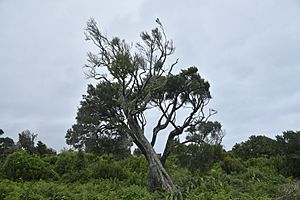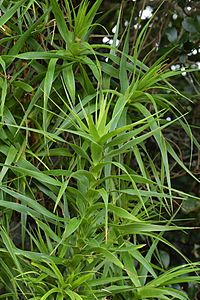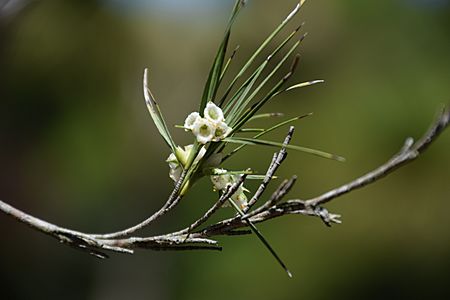Chatham Island grass tree facts for kids
Quick facts for kids Chatham Island grass tree |
|
|---|---|
 |
|
| Conservation status | |
|
Invalid status (NZ TCS)
|
|
| Scientific classification | |
| Synonyms | |
|
The Chatham Island grass tree, also known as tarahinau (its Māori name), is a special tree called Dracophyllum arboreum. It belongs to the plant family Ericaceae, which also includes heather and blueberry plants. This tree is found only on the Chatham Islands, a group of islands far east of New Zealand.
The Chatham Island grass tree can grow quite tall, up to 18 meters (about 60 feet). It's unique because its leaves look very different when the tree is young compared to when it's fully grown. It has small white flowers that bloom all year, and these flowers later turn into tiny brown fruits.
Contents
What Does It Look Like?
The Chatham Island grass tree, or Dracophyllum arboreum, is a tree that can reach heights of 4 to 18 meters. Its bark is a grayish-brown, while its new branches are a reddish-brown color.
One of the most interesting things about this tree is its leaves. They are dimorphic, which means they have two very different forms depending on the tree's age.
- Young leaves: When the tree is young, its leaves are light green. They are quite long, about 10–22 cm (4–8.5 inches) long and 1–1.8 cm (0.4–0.7 inches) wide.
- Adult leaves: As the tree grows older, its leaves change dramatically. The adult leaves are much smaller and thinner, like needles. They are 2.5–9 cm (1–3.5 inches) long and only 1–2 mm (less than 0.1 inch) wide. These adult leaves are glabrous, meaning they are smooth and hairless. Their edges, however, have tiny hairs.
This tree blooms with flowers all year round. The flowers grow in spikes at the end of branches, with 4 to 9 flowers on each spike. The flowers are white and shaped like an oval. They are sessile, which means they attach directly to the plant without a small stalk.
After flowering, the tree produces small, dark brown fruits, also all year round. Inside each fruit is a tiny yellowish-brown seed.
How It Was Named and Classified
The first person to describe D. arboreum was a botanist named Leonard Cockayne. He wrote about it in 1901, and his description was published in 1902. Even though he didn't give a full description, he noticed that the differences between the young and adult leaves were enough to make it a separate species from a similar tree, Dracophyllum scoparium.
Later, in 1952, another botanist named W. R. B. Oliver looked at the Dracophyllum group again. He moved D. arboreum into a different group, saying it was more similar to D. sinclairii in how it grew and its general look. Scientists are still studying the genetics of these plants, so how they are grouped might change in the future.
The name Dracophyllum comes from Ancient Greek words meaning "dragon-leaf." This is because the genus looks similar to plants in the Dracaena genus, which are sometimes called "dragon trees." The second part of its name, arboreum, is Latin for "tree-like."
Where It Lives
The Chatham Island grass tree is endemic to the Chatham Islands. This means it's found naturally only in this specific place. The Chatham Islands are located about 800 kilometers (500 miles) east of New Zealand's South Island.
You can find this tree on Chatham Island, Rangiuria, and Rangatira Island.
- On Chatham Island, it grows a lot in the lowland forests and drier swamp areas. It's also found where Moorland meets the forest.
- On Pitt Island (also called Rangiuria), D. arboreum is a main tree in the upland forests, growing alongside other plants like Brachyglottis huntii and various types of tree ferns.
How It Survives in Nature
The Chatham Islands are very windy! The average wind speed there is about 24 kilometers per hour (15 miles per hour). In 1993, winds were recorded as high as 157 km/h (98 mph)!
To survive these strong winds, D. arboreum has adapted. It is heteroblastic, which means its leaves change shape as it grows. When it's young, it has large leaves. But as it gets older, its leaves become thin and needle-like. These thinner leaves help the tree by reducing the stress from strong winds on its branches.
Some plants on mainland New Zealand also change their leaf shape as they grow, like the Lancewood. This was likely an adaptation to protect them from large, now extinct, browsing birds like the Moa. However, the Chatham Islands never had these large birds. So, the Chatham Island grass tree likely developed its changing leaf shape because of the windy weather.
Sometimes, D. arboreum can even start its life as an epiphyte. This means it begins growing on another plant, often a tree fern. Its roots then grow downwards, eventually reaching the ground and forming its own trunk.
Growing Your Own
You can try to grow D. arboreum from its seeds. However, it can be a bit tricky to keep alive. This tree prefers soil that is damp, acidic, and peaty, similar to the conditions found on Chatham Island where it naturally grows.
Images for kids






